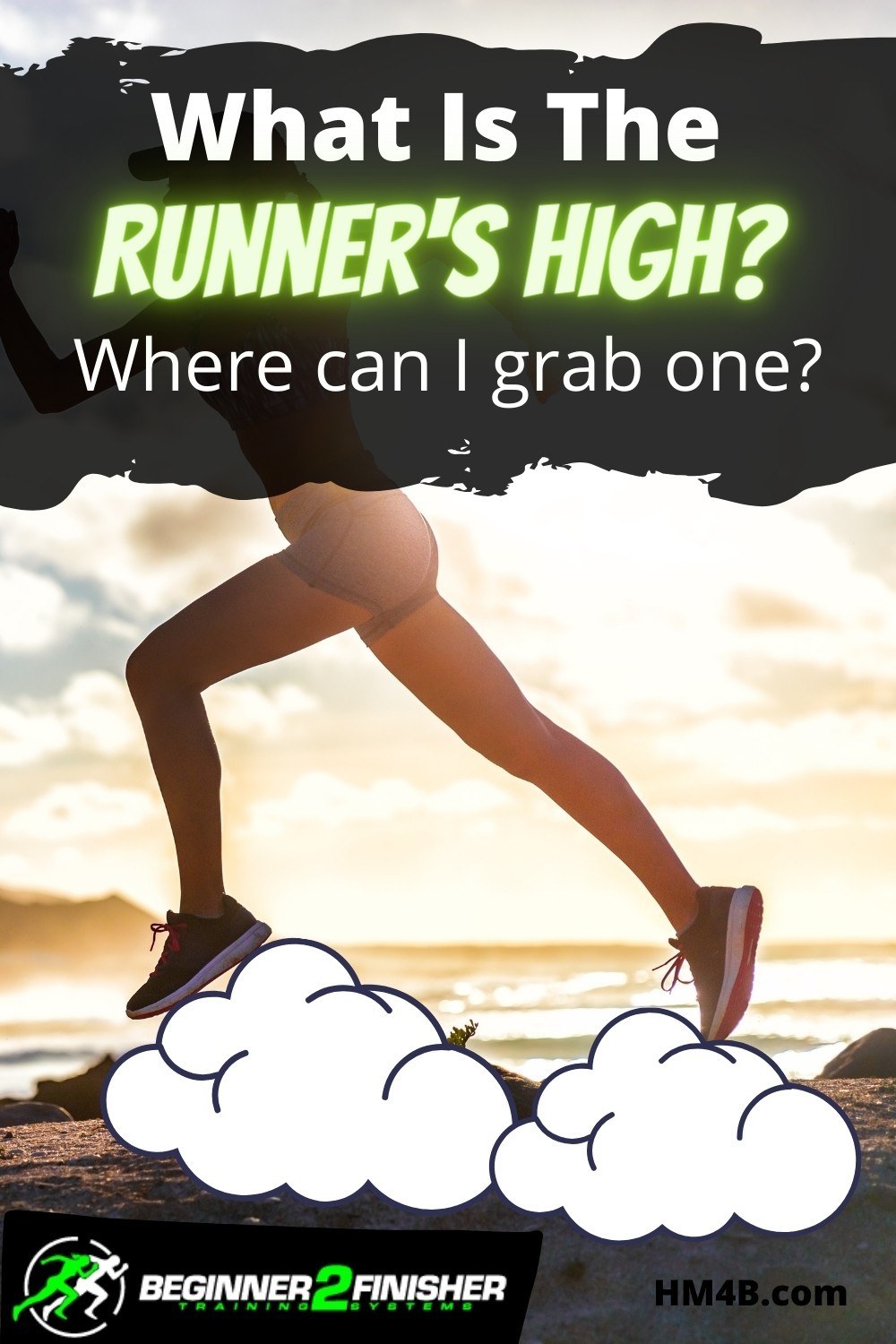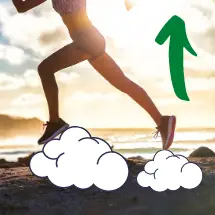If you’ve never experienced the elusive “Runner’s High” you’re missing out on a feeling of absolute euphoria. Even though your body is under enduring stress while running some runners reach a point where your body releases a flood of feel-good endorphins numbing the body. So what is a runner’s high?
The runner’s high is a sensation of elation or happiness that is brought about by cardiovascular exercise. Runners seek out the high by doing certain workouts and pushing their limits. The feeling can become a great incentive to exercise and boost your mental health.
Let’s look at the runner’s high in some more detail.
Why Is It Called A Runner’s High?
The feeling is called a runner’s high because of the sensation of a heightened mood. It is associated with runners because it is typically brought on by long sessions of aerobic exercise such as running.
In fact, a rower’s high is a different name for the same feeling when caused by rowing. Any long period of aerobic exercise—in which you push your cardiovascular system, getting out of breath, and raising your heartbeat—has the potential to induce a runner’s high.
Athletes and joggers who have experienced the runner’s high claim it causes a sense of euphoria in which anxiety and pain are lessened and feelings of comfort and calm are heightened. Not only that but you may even feel more energetic because of the high.
There are many people who exercise in the morning to feel the beneficial effects of the runner’s high throughout the day.
Is The Runner’s High Real?
There are arguments surrounding whether the runner’s high is a real objective sensation. Some people may experience a runner’s high every time they run, while some may never achieve the feeling. Personally, I do not feel a runner’s high until hours after the run itself.
There is also discussion about what the runner’s high actually is, whether it is a euphoric sensation felt during a run, or what is known as the ‘afterglow effect’ felt after a run. Either way, both sensations are caused by running or other forms of aerobic exercise.
Even if you cannot achieve the sensation entirely or very intensely, there is no doubt that exercising has a positive effect on mood. This is because when you exercise your body releases endorphins and endocannabinoids that cause positive mental states.
Endocannabinoids are the body’s natural form of THC, which is the psychoactive chemical that induces a high from ingesting cannabis. Researchers believe that the body’s ability to reward the individual after exercise evolved to help us run long distances to hunt large prey.
The term ‘runner’s high’ may perhaps make people imagine feeling a far more intense sensation than the real benefits experienced. Realistically the feeling may be far more passive, such as having a better response to a stressful situation, or a better night’s sleep.
What Type Of Running Workouts Cause The Runner’s High?
The type of workouts that are typically associated with a runner’s high are ones that push you that little bit past what you thought your limit was. As our bodies get fitter each workout or run will feel easier. To get the same benefits you will always need to push yourself.
High-intensity workouts are hailed by some to be the best way to achieve a runner’s high. Short and sharp periods of sprinting are used alongside periods of active resting—where you continue running but at a slower pace—to keep the heart rate and breathing high.
A good example of a High-Intensity workout would be to run your usual route but to run fast for 1 minute then slower for 2 minutes. Keep switching between the two speeds. It will make the run harder and will tax your body, making the release more painkilling and mood-enhancing chemicals.
Just remember that the more you push your body, the more endorphins and endocannabinoids will be circulated around your system. For me, a fast 3-mile run is enough to provide positive mental benefits for the rest of the day.
On days where I run further, the ‘high’ is less intense as the run was done at a slower, more endurance-based pace. I find that the more I push or shock my cardiovascular system, the calmer I will feel for the rest of the day.
Can You Get A Runner’s High From Walking?
Although the runner’s high—as the name suggests—is associated with running, it is not impossible to experience the same sensation from other forms of exercise. Walking is typically a more leisurely exercise, but when done right, may also induce positive mental effects.
Walking and/or hiking up steep hills and over rough terrain will be far more of a workout for your body. Basically, any exercise that gets you out of breath and sweating like running would be an effective way of achieving the runner’s high.
Strap on your hiking boots and do some hill repeats—walking up and down a steep hill at a pace faster than your normal walk. This will get you out of breath and can even work your leg muscles in different ways than running would.
Walking uphill targets the muscles on the back of your legs and your butt more so than running does. Some athletes and amateur exercisers feel a high from having that sore muscle feeling the next day.
Although you may not be as masochistic as some world-class athletes or those intense walkers with the poles and the best clothing, walking done the right way can induce positive mental effects.
Why Do I Have Trouble Getting A Runner’s High?
Sadly for some, the runner’s high might be just out of reach. Everybody is different, meaning everybody’s body responds differently to stimuli. Where one person may feel great after running for the bus, others might not feel anything after an intense run.
A good way to tell if exercise is helping your mood, whether or not you feel an actual ‘high’ is to rate your mood out of 10 before a run, then rate it again after your run, and then again two hours later. You may find that although you did not feel high, your mood has improved.
Another reason you may not experience a runner’s high is that you are just too fit to get to the point at which your body is stressed enough to reward you. Many athletes or people who exercise for work may not be able to get the runner’s high because their body is adapted to the exercise.
Do not be disheartened if you do not experience a runner’s high as much as some other people claim to. Exercising often is a great way to keep your body healthy whether or not you get a high each time you do it. Perhaps happiness will come from looking in the mirror a few months later.
How Long Does The Runner’s High Last?
Again, there is a debate as to what the runner’s high is and how long it lasts. Some believe it to be a brief period during exercise in which a feeling of euphoria is experienced, while some believe it to be the positive mental afterglow effect felt after a run.
For me personally as an intermediate runner—averaging around 15 miles a week—the run itself is painful no matter what. It is only an hour or so after the run that I start to feel calmer, less stressed, and more inclined to tackle that work I have been avoiding.
Although the feeling is less of a ‘high’ and more of passive contentment, the feeling lasts for the rest of the day after running. I can only speak for myself, however. For you, the feeling might be far more euphoric and intense during or immediately after a run.
Either way, the feeling is a pleasant one and will make you want to repeat the experience. Like some illegal drugs, the runner’s high can even become addictive for certain people. There are far worse things to be addicted to in my opinion.
The Takeaway
So, the runner’s high is a sensation of euphoria brought on by our body’s response to hard aerobic exercise. The feeling is caused by the release of endorphins and endocannabinoids into the body to lessen pain and tiredness. It likely evolved to help early humans hunt.
Doing an intense run or another form of intense aerobic exercise such as cross-training. Cross-training could include rowing, cycling, and even steep hiking which could possibly let you experience the high. As well as a potential euphoric state brought on during the exercise, an afterglow effect is well known.
Exercising in the morning can help you deal with stress better throughout the day as your mood is calmer and your stress hormones are quietened by more positive chemicals. Why not try getting in a few miles before your big meeting or before that presentation.
Although most people find running uncomfortable, the benefits far outweigh the pain. Just a few miles three times a week is enough to feel the positive effects of running. Not only mental but physical gains can be had by adding a short bit of exercise to your daily routine.
Related: Why Do I Feel Tired After I Run (besides exerting energy)?
| Help support me and subscribe to my YouTube channel. YouTube video - 30 ways to make your runs less painful! Coach Scott's Credentials:
|
To sign up for a FREE half marathon training schedule, log sheet, and pace predictor CLICK HERE.

Recommended gear for runners
Connect with me:
| facebook.com/BeginnerToFinisher/ |
References
https://www.healthline.com/health/runners-high#about-endocannabinoids
https://www.scientificamerican.com/article/new-brain-effects-behind-runner-s-high/


5 thoughts on “What Is A Runner’s High? Where can I find or buy one?”